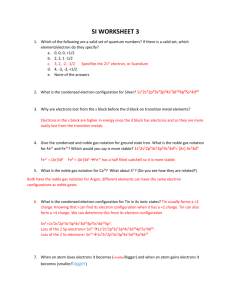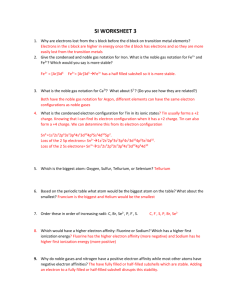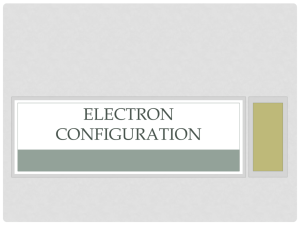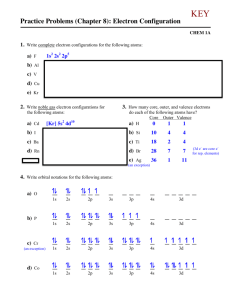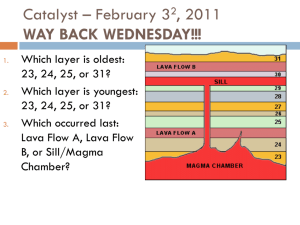Electron Configuration and Lewis Dot Diagram
advertisement
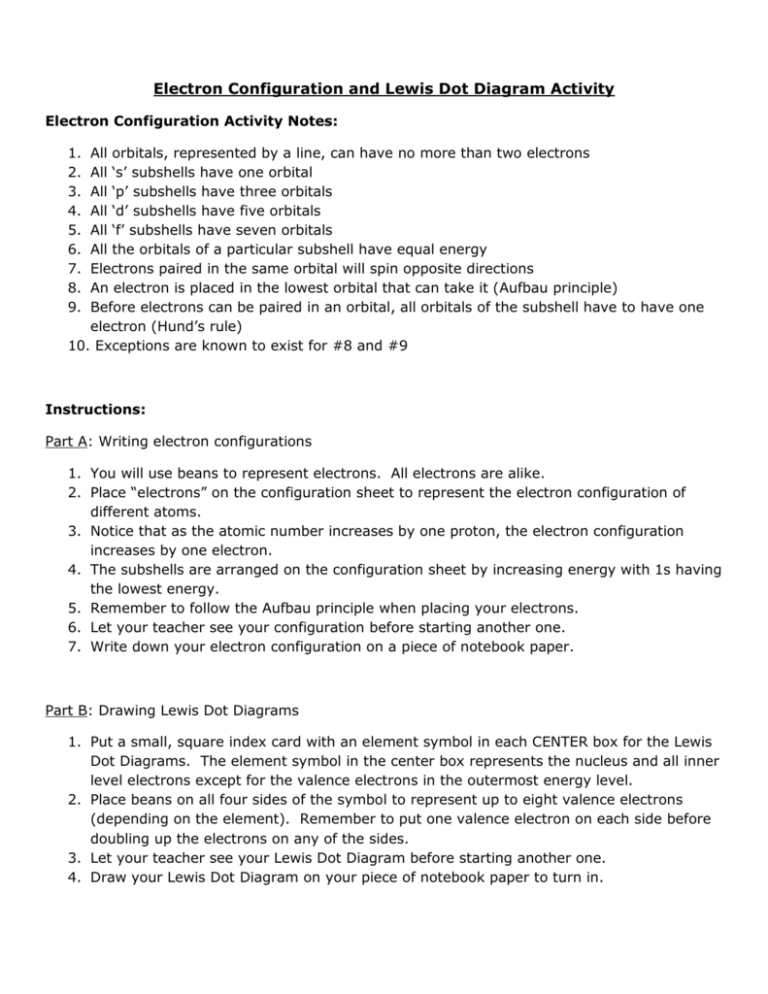
Electron Configuration and Lewis Dot Diagram Activity Electron Configuration Activity Notes: 1. 2. 3. 4. 5. 6. 7. 8. 9. All orbitals, represented by a line, can have no more than two electrons All ‘s’ subshells have one orbital All ‘p’ subshells have three orbitals All ‘d’ subshells have five orbitals All ‘f’ subshells have seven orbitals All the orbitals of a particular subshell have equal energy Electrons paired in the same orbital will spin opposite directions An electron is placed in the lowest orbital that can take it (Aufbau principle) Before electrons can be paired in an orbital, all orbitals of the subshell have to have one electron (Hund’s rule) 10. Exceptions are known to exist for #8 and #9 Instructions: Part A: Writing electron configurations 1. You will use beans to represent electrons. All electrons are alike. 2. Place “electrons” on the configuration sheet to represent the electron configuration of different atoms. 3. Notice that as the atomic number increases by one proton, the electron configuration increases by one electron. 4. The subshells are arranged on the configuration sheet by increasing energy with 1s having the lowest energy. 5. Remember to follow the Aufbau principle when placing your electrons. 6. Let your teacher see your configuration before starting another one. 7. Write down your electron configuration on a piece of notebook paper. Part B: Drawing Lewis Dot Diagrams 1. Put a small, square index card with an element symbol in each CENTER box for the Lewis Dot Diagrams. The element symbol in the center box represents the nucleus and all inner level electrons except for the valence electrons in the outermost energy level. 2. Place beans on all four sides of the symbol to represent up to eight valence electrons (depending on the element). Remember to put one valence electron on each side before doubling up the electrons on any of the sides. 3. Let your teacher see your Lewis Dot Diagram before starting another one. 4. Draw your Lewis Dot Diagram on your piece of notebook paper to turn in. Full Electron Configurations vs. noble Gas Configurations In the following activity you will use inductive reasoning to formulate a plan for writing Noble Gas electron configurations. Inductive reasoning is used when you gradually build up an understanding of how something works by studying specific examples of something and eventually coming up with a general law or principle. Study the pairs of electron configurations for Chlorine, Silver, and Calcium. Full e- configuration for Cl: Noble Gas e- configuration for Cl: 1s2 2s2 2p6 3s2 3p5 [Ne] 3s2 3p5 Full e- configuration for Ag: Noble Gas e- configuration for Ag: 1s2 2s2 2p6 3s2 2p6 4s2 3d10 4p6 5s2 4d9 [Kr] 5s2 4d9 Full e- configuration for Ca: Noble Gas e- configuration for Ca: 1s2 2s2 2p6 3s2 3p6 4s2 [Ar] 4s2 The Noble Gas configuration is a shortcut method of writing the electron configuration of an element. 1. In the Noble Gas configurations, where are all of the elements in [brackets] found on the periodic table? 2. Chlorine is in the ________ period on the periodic table. Neon, the noble gas used for its shortcut configuration, is in the ________ period. 3. Silver is in the ________ period on the periodic table. Krypton, the noble gas used for its shortcut configuration, is in the ________ period. 4. Calcium is in the ________ period on the periodic table. Argon, the noble gas used for its shortcut configuration, is in the ________ period. 5. Using these three examples, explain how you would determine which noble gas to use if you were going to write the noble gas shortcut for any other element. _______________________________________________________________________________ _______________________________________________________________________________ _______________________________________________________________________________ 6. Carefully study what is the SAME and what is DIFFERENT about the full e- configuration and the noble gas e- configuration in each pair. Can you make a general statement about what the bracketed noble gas replaces when going from the full configuration to the noble gas configuration? You will need to refer to your periodic table to figure this out. (hint: it might help to point to both the element the configuration is written for and the noble gas being used in the shortcut) _______________________________________________________________________________ _______________________________________________________________________________ _______________________________________________________________________________ 7. Write the Noble Gas configurations for the following elements: Carbon ___________________ Arsenic ___________________ Sulfur ___________________ Niobium ___________________ Lead ___________________ Francium ___________________ Electron Configuration Practice and Review Directions: Read the instructions for each section below and answer in the space provided. Show all work for credit. Part I: Write the full electron configuration for the following elements. 1. Lithium: 2. Chlorine: 3. Silver: Part II: Write the noble gas electron configuration for the following elements. 4. Calcium: 5. Beryllium: 6. Arsenic: Part III: Draw the Lewis Dot structure for the following elements in the box provided. 7. Helium 8. Fluorine 9. Xenon 10. Silicon 11. Potassium Part IV: Identify the element from the following electron configurations. 12. 1s2 2s2 2p4 14. [Ar] 4s2 13. 1s2 2s2 2p6 3s2 3p5 15. [Kr] 5s2 4d9 Part V: Identify the highest energy level and how many electrons are in the highest energy level. 16. Lithium 18. Rhodium 17. Cesium 19. Xenon Part VI: Answer the following question in complete sentences. 20. What are valence electrons and what is their main function?


